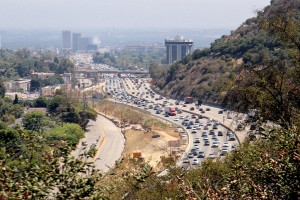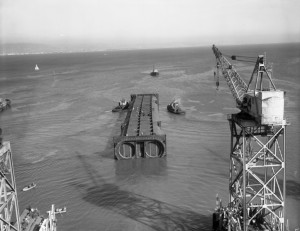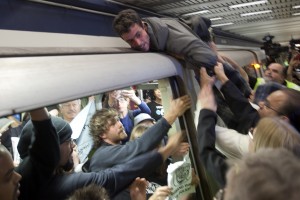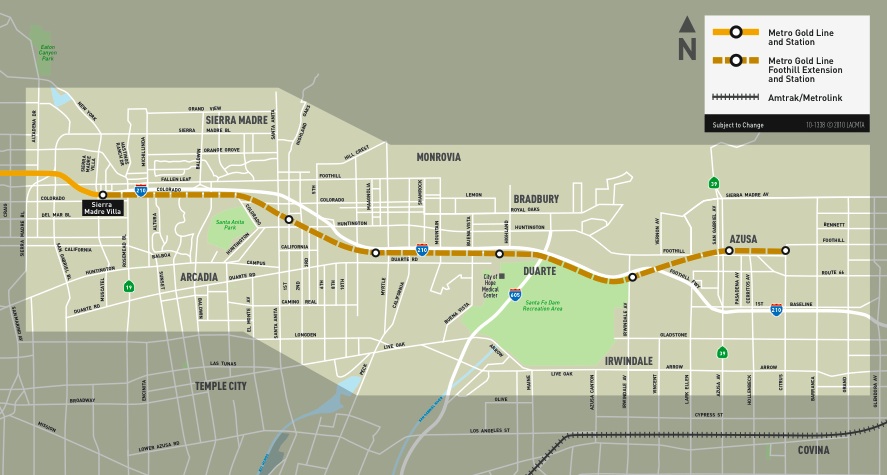 In response to my Los Angeles Times op-ed last week criticizing the Gold Line Foothill extension for not being a cost-effective use of taxpayer dollars, Los Angeles County Metro Vice Chairman and Duarte Councilman John Fasana and San Gabriel Valley Council of Governments President and Glendora Mayor Pro Tem Gene Murabito wrote a letter to the Times in rebuttal.
In response to my Los Angeles Times op-ed last week criticizing the Gold Line Foothill extension for not being a cost-effective use of taxpayer dollars, Los Angeles County Metro Vice Chairman and Duarte Councilman John Fasana and San Gabriel Valley Council of Governments President and Glendora Mayor Pro Tem Gene Murabito wrote a letter to the Times in rebuttal.
Their arguments boil down to three points:
- The San Gabriel Valley extension was cheap to build. True, but that doesn’t change the cost-effectiveness equation. It’s about ridership, too, and this line and its further extension to Montclair score weakly in that regard (for example, see page 47 of this draft report PDF ranking rail transit projects for Metro back in 2006).
- Projected ridership on the route is expected* to be great! *15 years from now. Yes, they say that by 2030 ridership should be comparable to other lines. I guess I’ll have to check in with them in a few decades to confirm. But in the meantime, the line is projected to carry just a fraction of the riders on the rest of the Gold Line, at 13,600 daily trips (compared to 40,000 for the rest of the line).
- Smart growth will happen along the route, boosting ridership to sufficient levels. Here is where Fasana and Murabito are actually able to address my concerns. More dense development around the stations, particularly with offices and affordable housing, could help salvage the investment.
But as Yonah Freemark pointed out back in 2010, many of the stations are in the middle of the freeway or otherwise not very pedestrian accessible, making transit-oriented development hard. And the developments that are being discussed appear to be of the parking-rich low-rise stuff — not what would be needed to boost ridership significantly.
In general, I think it could make sense to build cheap rail transit to areas where development will be built (“skating to where the puck is going”). So I’m not opposed to the principle that Fasana and Murabito espouse to justify this investment. But regional transit leaders should have gotten better assurance that sufficient transit-oriented development will and could be built before they coughed up the money.
Finally, I can’t help but note Fasana and Murabito’s charge in the opening of their letter that I “turn[ed] a blind eye to many facts due to his parochial view of the county’s transportation problems.” If advocating for rail transit in densely populated parts of Los Angeles County makes me parochial, then guilty as charged.
But I have to admit, it’s pretty rich to be accused of parochialism from a part of the county that threatened to torpedo the entire Measure R county sales tax proposal back in 2008 if they didn’t get this local project funded. Not to mention that they’re from a part of the county where people complain when more population-rich areas get rail transit funds first, as if people in the San Gabriel Valley don’t work in these job centers or benefit from the economic growth concentrated there. If ever there was a region of the county that cornered the market on parochialism, it would have to be the San Gabriel Valley.
Otherwise, I certainly don’t begrudge Fasana and Murabito for sticking up for their project. And they may be right that the ridership numbers will pan out. But if they really want to change my mind, they need to get to work ensuring that dense development actually is planned and built in the station neighborhoods.
And in the meantime, regional leaders should work to make sure that over-sized investments like the Foothill extension don’t happen again, at least not without better assurance that ridership projections will actually materialize.
After I first moved to Los Angeles in 1999, I got a job at a record company in Santa Monica. Being new and shocked by the traffic, I remember asking one of my co-workers about his commute. He lived in the San Fernando Valley, which meant a dreaded daily ride on Interstate 405 over the Santa Monica Mountains, through the bottleneck of the Sepulveda Pass. I shuddered in horror and asked him how he managed.
“I watch Lakers games,” he told me.
That didn’t make sense to me (especially being in the era before the smart phone): how could he drive and watch the games at the same time?
“I bring a small TV with an antenna and put it on the passenger seat,” he explained. “Traffic moves so slowly I can catch most of the game.”
I couldn’t help thinking of this long-lost colleague on Friday. That day, Los Angeles County’s transportation agency released a bold $120 billion long-term transportation plan with projects that would be funded if two-thirds of the voters approve a November half-cent sales tax increase.
The centerpiece of the plan? A transit tunnel and toll road for that 405 corridor.
To meet that two-thirds hurdle, L.A. Metro will need this kind of big, splashy project to capture the public imagination. It will also need to spread the goodies around the county to keep everyone happy (the benign sounding expression to describe this dynamic is “geographic equity”). And the plan has plenty of the transportation Santa Claus in action, with gold-plated rail extensions to the low-density San Gabriel Valley as the most prominent example.
Otherwise, there’s certainly a lot to like:
- The badly needed Wilshire subway to Westwood would be accelerated by a decade.
- Heavily traveled Vermont Avenue in South Los Angeles would get a bus rapid transit line (back in the 1980s planners wanted the Blue Line light rail to be heavy rail underneath this road).
- The crowded and too-slow Orange Line busway in the San Fernando Valley would get grade separations to speed it up.
- The aforementioned toll road on and transit tunnel under 405 could potentially bring in private funding for transit improvements to this crowded corridor. It’s a model the region needs to explore given the lack of public funds for big infrastructure projects.
What’s not to like? Well, in addition to the gold-plated project discussed above, there are a lot of highways involved, as seems to be required with transportation sales tax measures (an all-transit tax doesn’t get you the two-thirds approval you need).
One highway project stands out as particularly destructive: Supervisor Antonovich’s pet “High Desert Corridor” project, which would link Palmdale to Victorville along the base of the San Gabriel Mountains. Eventually the route would provide a path for California’s high speed rail project to connect to the Las Vegas high speed line, which currently is planned to end in Victorville.
But building this highway project will only encourage sprawl development in a beautiful part of the county, far from jobs and requiring long commutes of anyone who lives there. The high speed rail line won’t help, as it will be too expensive for daily commuting.
In the end, transportation leaders will need to run a flawless campaign to get the voters to approve this plan. The measure is apparently polling at 70%, which is a good start, but an anti-tax opposition campaign, coupled with any agency mishaps (like a construction accident or scandal) could sink it quickly. And debates over transit-oriented density could also sap support.
But Angelenos are clearly fed up with the status quo on transportation and seem poised to tax themselves again at record levels.
Because passing the time while stuck in traffic watching a Lakers game is simply not a sustainable option.
 Transit is often sold as a means of congestion relief. But the reality is that transit at best simply provides an alternative to congestion. Coupled with growing populations, any reduced traffic on highways that comes from new transit typically just induces new demand to fill it.
Transit is often sold as a means of congestion relief. But the reality is that transit at best simply provides an alternative to congestion. Coupled with growing populations, any reduced traffic on highways that comes from new transit typically just induces new demand to fill it.
L.A. Weekly reporter Gene Maddaus explores this topic and focuses on the real benefits of transit: building car-free neighborhoods around the stations. What better way to avoid congestion than to live close to a rail line that takes you to your job and many other destinations?
He studied three cities within LA and their efforts to densify around rapid transit, concluding with observations about Pasadena as a model:
Transit advocates often point to Pasadena as a place where transit-oriented development was done right. The Gold Line, which opened in 2003, spawned high-density residential development in the city’s downtown, building on previous success in transforming Old Pasadena into an attractive shopping destination.
“It’s ‘urban lite,’” says Greg Gunther, a past president of the Downtown Pasadena Residents Association. “With the convenience of the Gold Line right there, you can hop on a train [and] have Sunday brunch downtown or have a bite in South Pasadena.”
But even in Pasadena, where things have gone relatively well, the city was still convulsed for years by heated debates over traffic and density. Most Pasadena homeowners have made their peace with it by now, but it’s still common to hear complaints about traffic tie-ups at the rail crossings on Del Mar or California boulevards.
It’s a familiar story in all three places of local groups organizing to thwart density, but they’re not always successful. It’s worth reading the article in full (and not just because he quotes yours truly). As Los Angeles contemplates another ballot measure for transit funding, issues of density and development will always loom in the background, even if the perception of congestion-relief takes center stage.
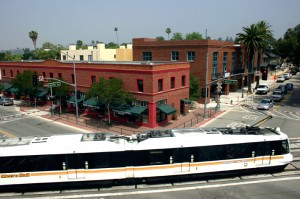 L.A. Metro has been hard at work cooking up a new list of big transit projects for the region, which would be funded with a new half-cent sales tax this November. The plan will be announced this Friday, but in the meantime, initial details leaked on some of the proposed projects last week, leading to this Los Angeles Times article from Laura Nelson:
L.A. Metro has been hard at work cooking up a new list of big transit projects for the region, which would be funded with a new half-cent sales tax this November. The plan will be announced this Friday, but in the meantime, initial details leaked on some of the proposed projects last week, leading to this Los Angeles Times article from Laura Nelson:
As envisioned, the plan would funnel about one-third of the $120 billion into full or partial funding for five new transit lines and at least six extensions of lines that are already built or under construction, the officials said.
The project list appears carefully constructed to gain voter support in all areas of the vast county, with rail lines, highway upgrades and other proposed improvements reaching communities as far-flung as Sylmar, Torrance, Artesia and Claremont.
That political dynamic — to spread the projects around the county to secure the needed two-thirds support — is the direct result of California’s Prop 13. It passed in 1978 and was eventually construed to require super-majorities for even local tax measures. As a result, self-help measures like a local transit tax must prioritize political benefits (i.e. geographic equity) over economic effectiveness or other needs.
I discussed this dynamic briefly in this short KPCC radio piece on Friday.
State leaders could really help regions like Los Angeles and other counties around the state if they allowed voters to reform Prop 13. Reducing the voter-approval threshold from two-thirds to 55% would not only ensure that locals could more easily raise funds for badly needed infrastructure, it could make those measures more effective by not having to please everyone and their mother.
The Los Angeles Times ran my op-ed today on the politics behind the Gold Line extension to Azusa:
Back in 2008, rail boosters needed two-thirds support from Los Angeles voters for the sales tax increase for transportation known as Measure R — a threshold required by Proposition 13. The measure would fund important transit projects all around the county, from the Purple Line subway under Wilshire Boulevard to the Expo Line to Santa Monica.
San Gabriel Valley leaders argued that their region was being unfairly left out of the coming transit boom, and they repeatedly threatened to block the measure from even appearing on the ballot. In reality, they were always slated to get a gold-plated rail line. But Metro officials had to give the Gold Line extension priority in the funding plan in order to secure voter support along the route.
In some ways, the Gold Line extension is the price we all had to pay to secure funding for more cost-effective rail lines in densely populated parts of the county, which are now under construction.
Now that the Gold Line extension is operational, San Gabriel Valley leaders should be proactive about creating demand along the route. They should do everything they can to build more housing and offices near the stations — the optimal way to capitalize on the investment.
I can’t emphasize that last point enough. Now that we’ve spent the money on rail, San Gabriel Valley leaders must salvage the investment through more transit-oriented development.
With the Gold Line opening in Los Angeles over the weekend, and the Expo Line to Santa Monica not far behind, Larry Mantle on KPCC radio’s AirTalk covered yesterday what these new lines will mean for mobility in the region.
I participated in the discussion along with Meghan McCarty, KPCC’s commuting and mobility reporter. You can listen here.
To my mind, the opening of these rail projects currently under construction will mean that we’ll finally have a functional rail network in Los Angeles. But that will still take years. The Purple Line subway, Crenshaw line, and regional connector are all a ways away from opening.
In the meantime, while I’m a wet blanket on the Gold Line extension to Azusa, the opening of Expo in a few months will mark a major milestone for rail in the region.
Saturday was a day of celebration for rail fans in the San Gabriel Valley in Los Angeles. The Gold Line extension from Pasadena to Azusa opened, marred only by apparently long lines to get the return train home and then later by a big rig crash on the freeway that shut the whole line down.
But while some rail fans celebrate, I’ll have to be the Debbie Downer here. The Gold Line extension should not have been built as rail, and it was solely the result of a political compromise needed to fund rail in other more meritorious parts of Los Angeles County. It brings rail to a low-density part of the county that would be more economically served by bus rapid transit or even commuter buses running in the right-of-way, at probably 20 percent of the costs of rail.
From the beginning, as I documented in my book Railtown, the Gold Line from Union Station to Pasadena was motivated by politics more than ridership. Higher ridership lines in other parts of the county were bypassed because the Pasadena route had powerful political backers, from then-Mayor Riordan to Republican representative David Dreier, who offered critical bipartisan support for rail in the U.S. Congress because he wanted it to serve his district.
Then this extension came along. Why build rail here, in this low-density part of the county (see the video above to check out the lack of development along the route)? Back in 2008, rail boosters needed two-thirds support from the county voters for the sales tax increase known as Measure R. The measure would fund important transit projects all around the county, from the Purple Line subway to the Expo Line to Santa Monica.
But San Gabriel Valley leaders threw a fit, and they almost refused to authorize the measure for the ballot, using their allies on the county board of supervisors and in Sacramento to threaten to torpedo the whole thing for everyone.
Why? They felt that they weren’t going to get any projects out of the measure. But in reality, they were slated to get this gold-plated rail line, even though they didn’t deserve it. They were like hostage takers who wanted 100% assurance they’d get their ransom, and this line was it.
Eventually they came around, with much cajoling, and Measure R passed with over two-thirds support. But this project is the consequence of Prop 13, which requires these voter super majorities. Much compromise is required, and therefore some waste of public funds.
In some ways, the Gold Line extension is the price the region has to pay to have more cost-effective rail lines in densely populated parts of the county. And now that the rail line is up, hopefully local leaders will do everything they can to build more housing and offices near the stations. That’s the best (and only) way to salvage this investment.
And if that happens, then the real celebrating can start.

